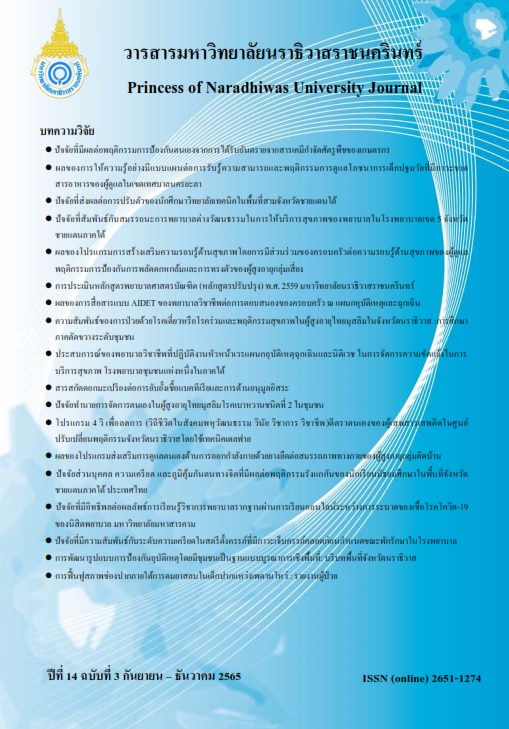Effects of AIDET Communication of Registered Nurses on Family Responses at Emergency Department
Keywords:
AIDET communication, Family responses, Critical emergency patients, Emergency departmentAbstract
Families are highly stressed, anxious, and fearful when faced with the life-threatening conditions of critically ill patients in emergency care and even higher during waiting for confronting with uncertainty situations of patients’ critical illness. Communication skills are a core competency for registered nurses to provide care and support to patients’ families. This quasi-experimental study aimed to compare the critically ill patient’s family response scores received from the nurses, in the experimental group, that communicated based on the Acknowledge, Introduce, Duration, Explanation, and Thank you’s (AIDET) paradigm; and based on normal communication paradigm. The sample consisted of 160 patients’ families who accompanied the patient and agreed to participate. They were randomly assigned to the experimental and control groups by triage nurses, sorted by severity according to the normal service system. A questionnaire was used to assess family responses and was developed from the reviewed literature. The content validity index was .96 and the reliability with Cronbach’s alpha coefficient was .98. Data were analyzed using independent samples t-test to compare differences in family responses’ scores.
The results showed that the overall average score regarding the family responses from nurses AIDET communication in the experimental group was significantly higher than in the control group (t = 21.96, p < 0.001). The study's findings suggested that the AIDET communication framework could be applied for nurses in the Emergency Department to appropriately communicate in supporting the patient families’ responses in critical events and to improve the satisfaction of emergency department services.
References
Blackburn, J., Ousey, K.J., & Goodwin, E. (2019). Information and communication in the emergency department. International Emergency Nursing, 42, 30-35.
Boonyaratkalin, P. (2019). Communicating with family of patients in Intensive Care Unit: Nurse’s role. Thai Red Cross Institute of Nursing, 12(2), 90-99.
Calder-Sprackman, S., Kwok, S.H., Bradley, R., Landreville, J., Perry, J.J., & Calder, A.L. (2021). Availability of emergency department wait times information: a patient-centered needs assessment. Emergency Medicine International, 1-6.
Chimchalong, R. (2021). Nurses’ communication techniques for handling with patients in palliative care. Journal of Prachomklao College of Nursing, Phetchaburi Province, 4(1), 1-16.
Donald, A, D., Stephen, O, C., Carey, D, B., & Ken, S. (2012). The all needs approach to emergency response.” Homeland Security Affairs 8, Article 1. Retrieved February 2012 from https://www.hsaj.org/articles/204.
Duvall, C,A., & Tumsen, T. (2018). Therapeutic communication skills for nurses. Journal of The Royal Thai Army Nurses, 19, 25-33.
Fu, K., Li, S., & Lu, S. (2020). Application and effect evaluation on Acknowledge-Introduce-Duration-Explanation-Thank you (AIDET) communication mode in cataract daytime operation nursing. Annals of Eye Science, 5(12), 1-8.
Jih-Shuin, J., Szu-Fen, H., Hsin-Yu, Y., Yi-Chun, C., Huang-Ju, L., Huey-Wen, L., & Jui-Sheng S. (2018). Comparison of complaints to the intensive care units and those to the general wards: an analysis using the Healthcare Complaint Analysis Tool in an academic medical center in Taiwan. Journal of Critical Care, 22, 2-12.
Karawanich, A., Anan, P., & Laorod, N. (2020). Development of practice guideline for Nurses Emergency Department Triage, Trat Hospital. Journal of Nursing Division, 47(3), 169-184.
Puppala, M., Ezeana, C.F., Alvarado, M.V., Goode, K.N., Danforth, R.L., Wong, S. S. ... Wong, S. (2020). A multifaceted study of hospital variables and interventions to improve inpatient satisfaction in a multi-hospital system. Medicine, 99 (51), 1-9.
Sangsongrit, N. (2017). Crisis in Emergency Department: Caring for patient’s relatives with humanized care nursing. Thai Red Cross Institute of Nursing, 10(2), 47-56.
Shilpa, J., Register, E.B., April, B., Andres, V., Stephanie, P.M., & Paul, M. (2020). Clinical Simulation in Nursing, 38, 14-17.
Soontorn, T., Pongtriang, P., & Songwathana, P. (2020). Thai family caregivers’ experiences helping dependent elders during medical emergencies: A qualitative study. Australasian Emergency Care, 23, 71-76.
Sriwichai, P., & Limprasert, K. (2019). Communication behavior among professional nurses at general hospital in Phayao province. Journal of Nursing and Health Care, 37(1), 138-147.
Stockwell, M., & Nishikawa, H. (1970). The Third Hand: A theory of support. Journal of Psychiatric Nursing-Mental Health Services, 8, 7-10.
Thangkratok, P., Poohomjarean, H., & Rinsathorn, S. (2017). Effects of AIDET communication program on satisfaction among patients and families in Cardiac Care Unit, Bangkok Heart Hospital. Songklanagarind Medical Journal, 35(4), 335-342.
Additional Files
Published
How to Cite
Issue
Section
License
Copyright (c) 2022 Princess of Naradhiwas University Journal

This work is licensed under a Creative Commons Attribution-NonCommercial-NoDerivatives 4.0 International License.




